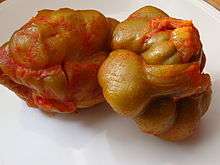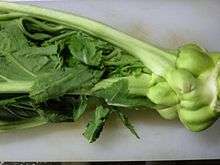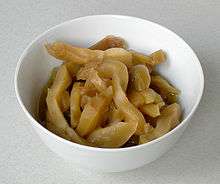Zha cai
Zha cai ([ʈʂâ tsʰâi]; 榨菜) is a type of pickled mustard plant stem originating from Chongqing, China. The name may also be written in English as cha tsai, tsa tsai, jar choy, jar choi, ja choi, ja choy, or cha tsoi. In English, it is commonly known as Sichuan vegetable, Szechwan vegetable, or Chinese pickled vegetable, although all of these terms may also refer to any of a number of other Chinese pickles, including the several other types in the Sichuan province itself.[1]
| Zha cai | |||||||||||||||||||||
|---|---|---|---|---|---|---|---|---|---|---|---|---|---|---|---|---|---|---|---|---|---|
 Whole heads of zha cai coated in chili paste | |||||||||||||||||||||
| Chinese | 榨菜 | ||||||||||||||||||||
| Hanyu Pinyin | zhà cài | ||||||||||||||||||||
| |||||||||||||||||||||
Production

The pickle is made from the knobby, fist-sized, swollen green stem of Brassica juncea, subspecies tsatsai. The stem is first salted, pressed, and dried before being rubbed with hot red chili paste and allowed to ferment in an earthenware jar. This preservation process is similar to that used to produce Korean kimchi.
Flavour
The taste is a combination of spicy, sour, and salty, while the aroma is similar to sauerkraut with hot chili paste. Its unique texture—crunchy, yet tender—can only be vaguely compared to Western pickled cucumbers. Zha cai is generally washed prior to use in order to remove the chili paste. Excess salt in the preserved vegetable is leached out by soaking in fresh water. Depending on the region and the brand, the flavor can be on the sweet, spicy, salty, or sour side.
Uses

Originating in Sichuan, zha cai is used in many of the various cuisines of China - for example as an "authentic" component of Sichuan dan dan noodles, in soups made with ground pork and mifen, or as a condiment for rice congee. It is generally sliced into thin strips and used in small amounts due to its extreme saltiness, although this saltiness can be tempered somewhat by soaking the strips in water prior to use.
A popular Chinese dish featuring zha cai is "noodles with Zha Cai and shredded pork" (榨菜肉絲麵; zhà cài ròusī miàn). Zha cai is also an ingredient of ci fan tuan, a popular dish in Shanghai cuisine.
In Japan, the pickle is common in Chinese restaurants (though it is usually less spicy, to suit Japanese tastes), and it is transliterated into Japanese as zāsai (katakana: ザーサイ; kanji: 搾菜).
Like other vegetable stems in Chinese cuisines, particularly celtuce, zha cai can also be sliced and sautéed.
See also
- List of pickled foods – List of links to Wikipedia articles on pickled foods
- Ya cai
- Meigan cai – A type of dry pickled Chinese mustard
- Pao cai – A type of pickle in Chinese, and particularly Sichuan cuisin
- Suan cai – Traditional Chinese pickled vegetables
- Tianjin preserved vegetable – A type of pickled Chinese cabbage originating in Tianjin, China